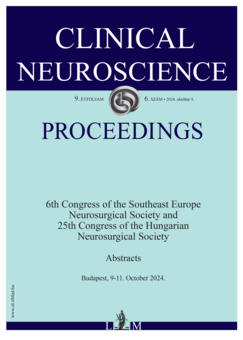Transnasal endoscopic surgery of skull base diseaes from scrub nurse point of view
SZENTESI Anett1, NAGY Gábor1
2024. OKTÓBER 09.
Ideggyógyászati Szemle Proceedings - 2024;9(6)
SZENTESI Anett1, NAGY Gábor1
2024. OKTÓBER 09.
Ideggyógyászati Szemle Proceedings - 2024;9(6)
Szöveg nagyítása:

Introduction: At our Depratment the skull base tumours were operated on via paraseptal, transnasal route with microscope. To introduce the endoscopic technique a different viewpoint and intsruments, such as the endoscop itselt, micro-Doppler, special endoscopic instruments, shaever, curved microsurgical drill, etc. were needed. For us scrub nurses the challenge is not the endoscopic technique but the transnasal route which could lead to complications. During the intervention the steril intracranial compartment is reached through a non-sterile route. This could be minimised with the profilactic and postoperative antiobiotics. To prevent the nasal liquorrhoe the skull base defect is covered by multiple layers. Depending on the size of the defect the covering is either Tachosil® only or fat in combination with nasoseptal or pericranial flap.
Method: Patient operated on endoscopic transnasal or endoscopic transnasal transcranial route between 1st July 2021 and 30th April 2024 were enrolled. Data were collected from our HOSPITALY database. Ninety-seven patients were operated on, age of the patients was from 3 months to 85 years (average 52.4years), among them 7 were children. There were 51 (52.6%) male and 46 (47.4%) female. Endoscopic transnasal operations were performed in 90 patients (92.8%) and combined in 7 (7.2%). Results and complications were examined prospectively.
Results: Fifty-two patients sufferd from pituitary adenoma (53.7%), benign tumour 17 (17.5%), malignant tumour 19 (19.5%), encephalocele 7 (7.2%) and chronic inflammation 2 (2.1%). The most frequent complication was nasal liquorrhoe in 16 (16.4%) and meningitis in 8 cases (8.2%). Reoperation was performed in 9 patients (9.2%), death occured in 4 cases. There were no complications among pediatric patients.
Conclusion: Our results and complications are in good correlation with the data of the literature.
Ideggyógyászati Szemle Proceedings
Despite evidence based institutional protocols being in place in many countries, aneurysmal subarachnoid hemorrhage (SAH) continues to be a major socio-economic burden with many open questions remaining regarding the optimal management of the affected patients.
Ideggyógyászati Szemle Proceedings
Arteriovenous malformation (AVM) is an anomaly of blood vessel formation. Numerous models have been established to understand the nature of AVM.
Ideggyógyászati Szemle Proceedings
Additive manufacturing has gained significant traction in industrial applications due to its high potential when it comes to manufacturing objects with complex geometry.
Ideggyógyászati Szemle Proceedings
Not only other surgical and robotic fields, but minimally invasive procedures in spine surgery have undergone significant development in recent times. A demand emerged from both surgeons and patients to develop and perform these types of surgeries in order to prevent biomechanical and surgical complications.
Ideggyógyászati Szemle Proceedings
Tumors in and around brain stem remain one of the biggest neurosurgical challenges due to com- plex anatomy of this “high valued real estate area.
Ideggyógyászati Szemle Proceedings
Arteriovenous malformation (AVM) is an anomaly of blood vessel formation. Numerous models have been established to understand the nature of AVM.
Ideggyógyászati Szemle Proceedings
Additive manufacturing has gained significant traction in industrial applications due to its high potential when it comes to manufacturing objects with complex geometry.
Ideggyógyászati Szemle Proceedings
Not only other surgical and robotic fields, but minimally invasive procedures in spine surgery have undergone significant development in recent times. A demand emerged from both surgeons and patients to develop and perform these types of surgeries in order to prevent biomechanical and surgical complications.
Hypertonia és Nephrologia
A vizsgálat célja az volt, hogy megtudjuk, hogy a korábban hagyományos módon (egy orvossal és egy OKJ-s ápolóval) működtetett háziorvosi praxis átszervezésével, magasan képzett szakdolgozók bevonásával és a hozzáférés növelésével, hogyan változott a hypertonia diagnosztizálása, a hatóanyagok felírása és a komorbiditások felismerése és kezelése az érintett praxisban. A praxis betegforgalmi és gyógyszerfelírási adatait a 2010–2022 közötti időtartam lekérdezésével vizsgáltuk.
Ideggyógyászati Szemle Proceedings
Pleomorphic xanthoastrocytomas (PXA) are rare grade2, occasionally grade 3 astrocytic tumors according to the current WHO classification. PXAs account for less than 1% of all astrocytomas.
Tailored patient specific skull base approaches to achieve maximal resection
The tailored concept in the minimally invasive, transnasal endoscopic surgery
1.
2.
3.
4.
5.
Egészségpolitika
Hadiállapotként kezeli és így is reagál a kormány az egészségügy „rendezésére”1.
2.
Orvoslás és társadalom
Országos férfiegészség-kampány és PSA-szűrés indul a prosztatarák ellen3.
4.
5.